The Arches Cluster, an open cluster in Sagittarius constellation discovered in 1995, is the densest cluster of its kind known in the Milky Way. It lies at a distance of 25,000 light years from Earth and only about 100 light years from the centre of the Milky Way.
The cluster is heavily obscured by dust in the visual bands and cannot be seen by the unaided eye, but it can be observed in infrared, radio and X-ray bands. It offers insights into star formation in an environment close to the Galactic centre.
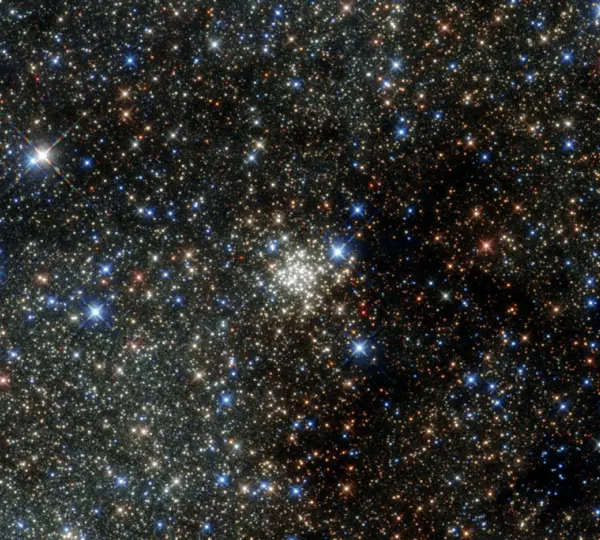
Arches Cluster. Image: NASA/ESA, 2015
The Arches Cluster contains about 135 large, massive, young, exceptionally hot stars and thousands of less massive members. The age of the cluster is estimated at 2.5 million years. The cluster is believed to have formed in a short, but massive burst of star formation.
It is a bit younger than the nearby Quintuplet Cluster, but considerably denser and larger than its neighbour. The oldest stars in the Arches Cluster have barely evolved from the main sequence, while the Quintuplet Cluster contains a number of much more evolved stars, including hot supergiants, a red supergiant and several luminous blue variables (LBV).
The Arches Cluster is very dense, with close to 150 hot young stars packed within a radius of 1 light year. For comparison, if a region with a radius equal to the distance between the Sun and its closest neighbour, Proxima Centauri, had the same density, it would contain more than 100,000 stars. X-ray observations have revealed an envelope of gas around the cluster, heated to 60 million degrees by the cluster’s stars intense stellar winds that are colliding with the interstellar medium.
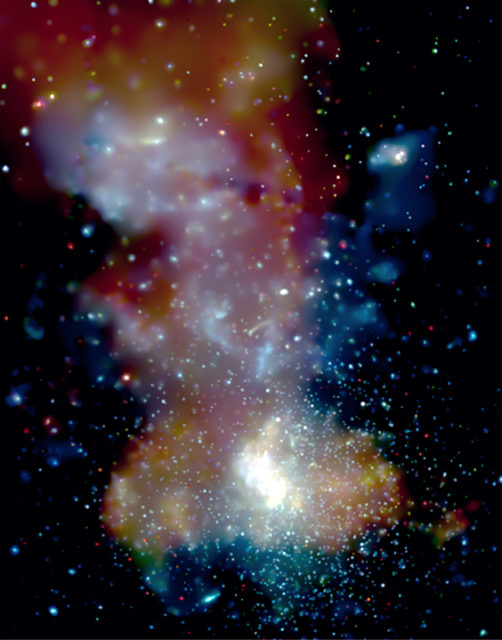
The clusters, Arches (upper right), Quintuplet (upper center), and the GC cluster (bottom center), contain massive stars that appear as very bright, point-like X-ray sources when winds from their surfaces collide with those from an orbiting companion. Vast amounts of energy are also released when these stars go out as supernovas, heating the surrounding material. Stellar corpses in this image also emit X-rays as either neutron stars or black holes in binary systems. Collisions between the clusters themselves and cooler molecular clouds of gas contribute to the diffuse X-rays seen in this image. Image: Chandra X-ray Observatory. NASA/CXC/UMass Amherst/Q.D.Wang et al. Smithsonian Institution @ Flickr Commons
The cluster has a mass equivalent to more than 10,000 Suns, which makes it 10 times heavier than typical open clusters in our galaxy.
The Arches Cluster was named for the arch-shaped filaments detected in its vicinity at radio wavelengths. These filaments are produced as a result of the cluster approaching and ionizing the surface of a molecular cloud that lies in the background. Similar interactions between a cluster and a molecular cloud are occurring in the Quintuplet Cluster.
Stars
The most massive stars in the cluster are Wolf-Rayet stars, exceptionally hot, highly luminous stars showing prominent emission lines of highly ionised helium and nitrogen or carbon.
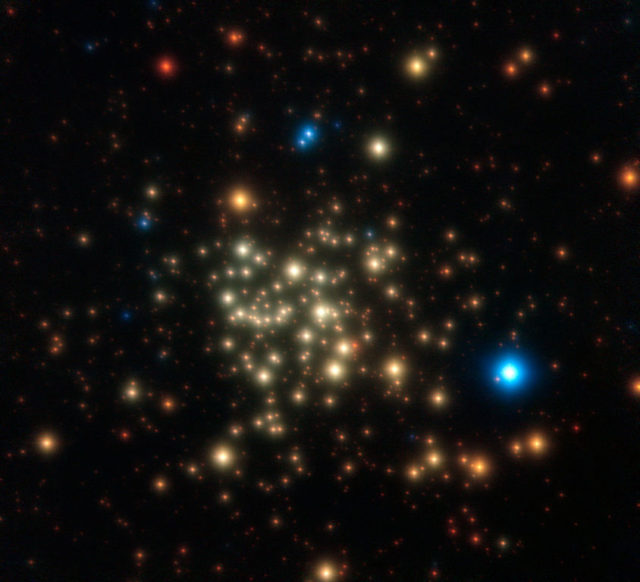
This image of the Arches Cluster of young, massive stars was obtained with NACO on ESO’s Very Large Telescope. The field of view is 28 arcseconds. North is up and east is to the left. This image is a composite of infrared images obtained through J, H and K filters. The stars appear as bright cores surrounded by faint diffuse halos. This is typical of images obtained by adaptive optics instruments. The halo corresponds to light that was not fully corrected for the blurring effects of the Earth’s atmosphere. Image: ESO/P. Espinoza, 2009
Wolf-Rayet stars are some of the most massive stars known. Some of them have a mass more than 100 times that of the Sun. Their stellar winds are enriched with helium and nitrogen. The Arches Cluster is believed to contain about 5 percent of all known Wolf-Rayet stars in the Milky Way.
The 28 brightest stars in the Arches Cluster are either H-rich WN7-9 stars or O-type supergiants with an age between 2 and 4 million years.
At least 150 of the member stars are some of the brightest stars ever discovered within our galaxy. Astronomers estimate that only one out of every 10 million stars in the Milky Way is as bright as the members of the Arches Cluster. The hot young stars in the cluster have relatively short lives, burning their fuel in only a few million years before they meet their ends as supernovae.
Arches Cluster
Constellation: Sagittarius
Right ascension: 17h 45m 50.5s
Declination: –28° 49′ 28″
Distance: 25,000 light years (8,500 parsecs)
Mass: 10,000 solar masses
Age: 2.5 million years
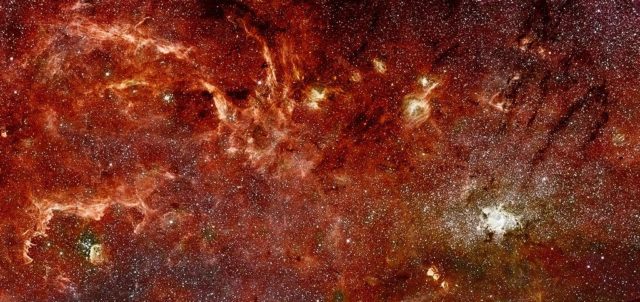
The Galactic core is obscured in visible light by intervening dust clouds, but infra-red light penetrates the dust. NICMOS shows a large number of these massive stars distributed throughout the region. A new finding is that astronomers now see that the massive stars are not confined to one of the three known clusters of massive stars in the Galactic Centre, known as the Central cluster, the Arches cluster, and the Quintuplet cluster. These three clusters are easily seen as tight concentrations of bright, massive stars in the NICMOS image. The distributed stars may have formed in isolation, or they may have originated in clusters that have been disrupted by strong gravitational tidal forces. The winds and radiation from these stars form the complex structures seen in the core, and in some cases, they may be triggering new generations of stars. Image – Hubble: NASA, ESA, and Q.D. Wang (University of Massachusetts, Amherst); Spitzer: NASA, Jet Propulsion Laboratory, and S. Stolovy (Spitzer Science Center/Caltech)
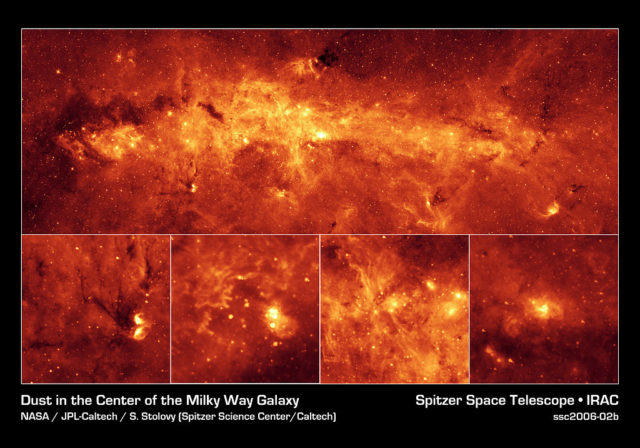
Our Milky Way is a dusty place. So dusty, in fact, that we cannot see the center of the galaxy in visible light. But when NASA’s Spitzer Space Telescope set its infrared eyes on the galactic center, it captured this spectacular view. Taken with just one of Spitzer’s cameras (at a wavelength of 8 microns), the image highlights the region’s exceptionally bright and dusty clouds, lit up by young massive stars. Individual stars can also be seen as tiny dots scattered throughout the dust. The top mosaic shows a portion of the galactic center that stretches across a distance of 760 light-years. Thanks to Spitzer’s excellent resolution, the dusty features within the galactic center are seen in unprecedented detail. Four examples are shown in the magnified insets at the bottom. The farthest left box shows a pair of star-forming regions resembling owl-like cosmic eyes. To the left of the “eyes,” dark lanes of dust can be seen. This object is probably located in a spiral arm between Earth and the galactic center, in contrast to the following examples, which are all located at the galactic center. The next inset to the right includes the exceptionally luminous “Quintuplet” stars, a set of five massive stars believed to have buried themselves in cocoons of dust. Just below and to the right of the Quintuplet is the “Pistol” nebula, a bubble of ejected material from the central, massive Pistol star. The finger-like pillars to the left are part of a structure known as “Sickle.” They are similar in size and shape to those in the famous picture of the Eagle Nebula taken by NASA’s Hubble Space Telescope. Pillars like these are sculpted out of dense dust clouds by radiation and winds from hot stars. The pillars in the Sickle were likely to have been formed by a cluster of hot stars located to their right but not readily visible here. The third inset highlights a system of long, stringy structures that are seen for the first time near the base of a region known as the “Arched Filaments.” These long filaments are about 10 light-years long and less than 1 light-year wide. The bright star-forming regions to the right are some of the brightest in the infrared sky. The final inset to the right shows the center of our galaxy, which is the brightest spot in the entire mosaic. The brightness is a result of dust being heated up by a compact cluster of hot stars. The bright spot also marks the location of a supermassive black hole, around which a rotating ring of gas and dust known as the circumnuclear disk can be seen. This image was taken with Spitzer’s Infrared Array Camera (IRAC), using its 8-micron detector. It shows emissions from heated-up molecules in dust clouds called polycyclic aromatic hydrocarbons. Image: NASA/JPL-Caltech/S. Stolovy (SSC/Caltech)